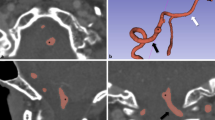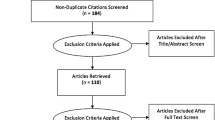Abstract
Purpose
Three-dimensional (3D) printing was invented in 1983 but has only just begun to influence medicine and surgery. Conversion of digital images into physical models demonstrates promise to revolutionize multiple domains of surgery. In the field of uro-oncology, researchers and clinicians have recognized the potential of this technology and are working towards making it an integral part of urological practice. We review current literature regarding 3D printing and other 3D technology in the field of urology.
Method
A comprehensive assessment of contemporary literature was performed according to a modified PRISMA analysis for the purposes of this narrative review article. Medical databases that were searched included: Web of Science, EMBASE and Cochrane databases. Articles assessed were limited only to English-language peer-reviewed articles published between 1980 and 2017. The search terms used were “3D”, “3-dimensional”, “printing”, “printing technology”, “urology”, “surgery”. Acceptable articles were reviewed and incorporated for their merit and relevance with preference given for articles with high impact, original research and recent advances.
Results
Thirty-five publications were included in final analysis and discussion.
Conclusions
The area of 3D printing in Urology shows promising results, but further research is required and cost reduction must occur before clinicians fully embrace its use. As costs continue to decline and diversity of materials continues to expand, research and clinical utilization will increase. Recent advances have demonstrated the potential of this technology in the realms of education and surgical optimization. The generation of personalized organs using 3D printing scaffolding remains the ‘holy grail’ of this technology.


Similar content being viewed by others
References
Ventola CL (2014) Medical applications for 3D printing: current and projected uses. P T 39(10):704–711
Wake N, Chandarana H, Huang WC, Taneja SS, Rosenkrantz AB (2016) Application of anatomically accurate, patient-specific 3D printed models from MRI data in urological oncology. Clin Radiol 71(6):610–614. https://doi.org/10.1016/j.crad.2016.02.012
Li J, Chen M, Fan X, Zhou H (2016) Recent advances in bioprinting techniques: approaches, applications and future prospects. J Transl Med 14:271. https://doi.org/10.1186/s12967-016-1028-0
Rengier F, Mehndiratta A, von Tengg-Kobligk H, Zechmann CM, Unterhinninghofen R, Kauczor HU, Giesel FL (2010) 3D printing based on imaging data: review of medical applications. Int J Comput Assist Radiol Surg 5(4):335–341. https://doi.org/10.1007/s11548-010-0476-x
Coles-Black J, Chao I, Chuen J (2017) Three-dimensional printing in medicine. Med J Aust 207(3):102–103
Shin T, Ukimura O, Gill IS (2016) Three-dimensional printed model of prostate anatomy and targeted biopsy-proven index tumor to facilitate nerve-sparing prostatectomy. Eur Urol 69(2):377–379. https://doi.org/10.1016/j.eururo.2015.09.024
Chao I, Young J, Coles-Black J, Chuen J, Weinberg L, Rachbuch C (2017) The application of three-dimensional printing technology in anaesthesia: a systematic review. Anaesthesia 72(5):641–650. https://doi.org/10.1111/anae.13812
Harrysson OLA, Hosni YA, Nayfeh JF (2007) Custom-designed orthopedic implants evaluated using finite element analysis of patient-specific computed tomography data: femoral-component case study. BMC Musculoskelet Disord 8:91. https://doi.org/10.1186/1471-2474-8-91
Transplant jaw made by 3D printer claimed as first (2017) http://www.bbc.com/news/technology-16907104. Accessed 19 Dec 2017
Silberstein JL, Maddox MM, Dorsey P, Feibus A, Thomas R, Lee BR (2014) Physical models of renal malignancies using standard cross-sectional imaging and 3-dimensional printers: a pilot study. Urology 84(2):268–272. https://doi.org/10.1016/j.urology.2014.03.042
Knoedler M, Feibus AH, Lange A, Maddox MM, Ledet E, Thomas R, Silberstein JL (2015) Individualized physical 3-dimensional kidney tumor models constructed from 3-dimensional printers result in improved trainee anatomic understanding. Urology 85(6):1257–1261. https://doi.org/10.1016/j.urology.2015.02.053
McMenamin PG, Quayle MR, McHenry CR, Adams JW (2014) The production of anatomical teaching resources using three-dimensional (3D) printing technology. Anat Sci Educ 7(6):479–486. https://doi.org/10.1002/ase.1475
Ukimura O, Nakamoto M, Gill IS (2012) Three-dimensional reconstruction of renovascular-tumor anatomy to facilitate zero-ischemia partial nephrectomy. Eur Urol 61(1):211–217. https://doi.org/10.1016/j.eururo.2011.07.068
Chen Y, Li H, Wu D, Bi K, Liu C (2014) Surgical planning and manual image fusion based on 3D model facilitate laparoscopic partial nephrectomy for intrarenal tumors. World J Urol 32(6):1493–1499. https://doi.org/10.1007/s00345-013-1222-0
Zhang Y, Ge HW, Li NC, Yu CF, Guo HF, Jin SH, Liu JS, Na YQ (2016) Evaluation of three-dimensional printing for laparoscopic partial nephrectomy of renal tumors: a preliminary report. World J Urol 34(4):533–537. https://doi.org/10.1007/s00345-015-1530-7
Maddox MM, Feibus A, Liu J, Wang J, Thomas R, Silberstein JL (2017) 3D-printed soft-tissue physical models of renal malignancies for individualized surgical simulation: a feasibility study. J Robot Surg. https://doi.org/10.1007/s11701-017-0680-6
von Rundstedt FC, Scovell JM, Agrawal S, Zaneveld J, Link RE (2017) Utility of patient-specific silicone renal models for planning and rehearsal of complex tumour resections prior to robot-assisted laparoscopic partial nephrectomy. BJU Int 119(4):598–604. https://doi.org/10.1111/bju.13712
de Luyk N, Namdarian B, Challacombe B (2017) Touching the future: three-dimensional printing facilitates preoperative planning, realistic simulation and enhanced precision in robot-assisted laparoscopic partial nephrectomy. BJU Int 119(4):510–512. https://doi.org/10.1111/bju.13800
Simpfendorfer T, Li Z, Gasch C, Drosdzol F, Fangerau M, Muller M, Maier-Hein L, Hohenfellner M, Teber D (2017) Three-Dimensional Reconstruction of Preoperative Imaging Improves Surgical Success in Laparoscopy. J Laparoendosc Adv Surg Tech A 27(2):181–185. https://doi.org/10.1089/lap.2016.0424
Manning TG, Christidis D, Coles-Black J, McGrath S, O’Brien J, Chuen J, Bolton D, Lawrentschuk N (2017) “Plug and Play”: a novel technique utilising existing technology to get the most out of the robot. J Robot Surg 11(2):235–238. https://doi.org/10.1007/s11701-016-0670-0
Marescaux J, Diana M (2015) Inventing the future of surgery. World J Surg 39(3):615–622. https://doi.org/10.1007/s00268-014-2879-2
Lee SL, Lerotic M, Vitiello V, Giannarou S, Kwok KW, Visentini-Scarzanella M, Yang GZ (2010) From medical images to minimally invasive intervention: computer assistance for robotic surgery. Comput Med Imaging Graph 34(1):33–45. https://doi.org/10.1016/j.compmedimag.2009.07.007
Mandrycky C, Wang Z, Kim K, Kim DH (2016) 3D bioprinting for engineering complex tissues. Biotechnol Adv 34(4):422–434. https://doi.org/10.1016/j.biotechadv.2015.12.011
Atala A, Kasper FK, Mikos AG (2012) Engineering complex tissues. Sci Transl Med 4(160rv112):112. https://doi.org/10.1126/scitranslmed.3004890
Soliman Y, Feibus AH, Baum N (2015) 3D printing and its urologic applications. Rev Urol 17(1):20–24
Del Junco M, Yoon R, Okhunov Z, Abedi G, Hwang C, Dolan B, Landman J (2015) Comparison of flow characteristics of novel three-dimensional printed ureteral stents versus standard ureteral stents in a porcine model. J Endourol 29(9):1065–1069. https://doi.org/10.1089/end.2014.0716
Kondor S, Grant G, Liacouras P, Schmid JR, Parsons M, Rastogi VK, Smith LS, Macy B, Sabart B, Macedonia C (2013) On demand additive manufacturing of a basic surgical kit. J Med Dev 7(3):030916
Del Junco M, Okhunov Z, Yoon R, Khanipour R, Juncal S, Abedi G, Lusch A, Landman J (2015) Development and initial porcine and cadaver experience with three-dimensional printing of endoscopic and laparoscopic equipment. J Endourol 29(1):58–62. https://doi.org/10.1089/end.2014.0280
Marro A, Bandukwala T, Mak W (2016) Three-dimensional printing and medical imaging: a review of the methods and applications. Curr Probl Diagn Radiol 45(1):2–9. https://doi.org/10.1067/j.cpradiol.2015.07.009
Mitsouras D, Liacouras P, Imanzadeh A, Giannopoulos AA, Cai T, Kumamaru KK, George E, Wake N, Caterson EJ, Pomahac B, Ho VB, Grant GT, Rybicki FJ (2015) Medical 3D printing for the radiologist. Radiographics 35(7):1965–1988. https://doi.org/10.1148/rg.2015140320
Cheng GZ, San Jose Estepar R, Folch E, Onieva J, Gangadharan S, Majid A (2016) Three-dimensional printing and 3D Slicer: powerful tools in understanding and treating structural lung disease. Chest 149(5):1136–1142. https://doi.org/10.1016/j.chest.2016.03.001
Rutula WA WD (2008) Healthcare Infection Control Practices Advisory Committee (HICPAC). Guideline for disinfection and sterilization in healthcare facilities 2008. CDC (Dept of Health and Human Services USA). http://www.cdc.gov/hicpac/pdf/guidelines/Disinfection_Nov_2008.pdf. 2017
Australia TGA (2017) Proposed regulatory changes related to personalised and 3D printed medical devices. Consultation paper. https://www.tga.gov.au/consultation/consultation-proposed-regulatory-changes-related-personalised-and-3d-printed-medical-devices. Accessed 19 Dec 2017
Hourd P, Medcalf N, Segal J, Williams DJ (2015) A 3D bioprinting exemplar of the consequences of the regulatory requirements on customized processes. Regen Med 10(7):863–883. https://doi.org/10.2217/rme.15.52
Morrison RJ, Kashlan KN, Flanangan CL, Wright JK, Green GE, Hollister SJ, Weatherwax KJ (2015) Regulatory considerations in the design and manufacturing of implantable 3D-printed medical devices. Clin Transl Sci 8(5):594–600. https://doi.org/10.1111/cts.12315
Author information
Authors and Affiliations
Contributions
All Authors contributed to the production of this manuscript. TGM: Protocol/project development, Data collection or management, Data analysis, Manuscript writing/editing, Revision writing/editing. JSO: Protocol/project development, Data collection or management, Data analysis, Manuscript writing/editing, Revision writing/editing. DC: Protocol/project development, Data collection or management, Data analysis, Manuscript writing/editing. MP: Data Analysis, Manuscript writing/editing, Revision writing/editing. JC-B: Protocol/project development, Data collection or management, Data analysis. JC: Protocol/project development, Data collection or management, Data analysis. DMB: Protocol/project development, Data collection or management, Data analysis. NL: Protocol/project development, Data collection or management, Data analysis
Corresponding author
Ethics declarations
Conflict of interest
The authors declare that they have no conflict of interest.
Human rights
This article does not contain any studies with human participants or animals performed by any of the authors.
Informed consent
Informed consent was obtained from all individual participants included in the study.
Rights and permissions
About this article
Cite this article
Manning, T.G., O’Brien, J.S., Christidis, D. et al. Three dimensional models in uro-oncology: a future built with additive fabrication. World J Urol 36, 557–563 (2018). https://doi.org/10.1007/s00345-018-2201-2
Received:
Accepted:
Published:
Issue Date:
DOI: https://doi.org/10.1007/s00345-018-2201-2




